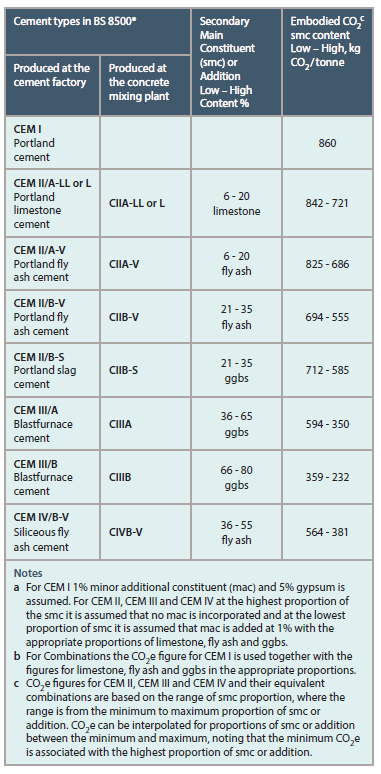Cementitious materials
'Cement’ generally refers to the powder component of concrete which, when mixed with water, becomes the glue-like material, or binder, that allows concrete to set, harden and strengthen. The cement content of concrete is normally in the range from 10-15% by volume.
Clinker and CEM I
Portland cement, or CEM I, is made by grinding clinker, which comes from the cement kiln, together with gypsum to produce a fine powder. Most cements in the UK contain a portion of clinker, and these are the cements on which the specification standard BS 8500 is based. Cements containing clinker as the key binding ingredient are produced either at the cement factory or at the concrete mixing plant.
Secondary cementitious materials or additions
Secondary cementitious materials (SCMs) are materials that may be used as part of cements. When added at the concrete mixing plant such SCMs are referred to as ‘cementitious additions’ as they are added to high clinker CEM I or CEM II/A cements. SCMs may be naturally occurring with minimal processing or may arise from wastes or by-products from other industries. The UK average for cementitious additions across all concretes is approximately 33%.
Secondary cementitious materials include fly ash, ground granulated blastfurnace slag (GGBS), limestone, silica fume, natural pozzolana and natural calcined pozzolana. Fly ash and GGBS are the most commonly used of these materials in the UK. These secondary materials are useful by-products of other industrial processes.
Embodied CO2 of typical UK Cements
Indicative ECO2 values for the main cementitious constituents of reinforced concrete are provided in Table 9 of Specifying Sustainable Concrete. These figures are derived using data from 2017/18 and represent ‘cradle to- factory-gate’ values as they do not consider transport from place of manufacture to concrete plants.

Net zero cement and concrete
The concrete and cement industry has a strong track record, having already delivered a 53% reduction in absolute carbon emissions since 1990 and is decarbonising, as a whole, faster than the UK economy. The industry has published a net zero framework to inform the delivery of an ambitious roadmap for the UK concrete and cement sector to deliver net negative emissions by 2050.
Both existing and emerging technologies including energy efficiency, fuel switching, low-carbon cements and concretes, and Carbon Capture, Usage or Storage (CCUS) are needed to deliver the UK Government’s net zero target. To go beyond net zero and deliver net negative, removing more carbon from the atmosphere than the industry emits each year, the emerging model will use the natural properties of concrete including carbonation and thermal mass. The roadmap will not rely upon carbon offsetting or offshoring of production for emissions reduction.